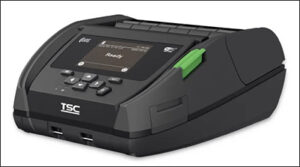- Clothing Retailer Charanga Deploys Nedap RFID Platform
- TSC Printronix Auto ID Intros Mobile RFID Printer
- Arm Adds Processors to Its IoT Product Portfolio
- Vubiq Networks Awarded RFID Technology Patent
- Memfault, Dimension Four Partner on IoT Smart Devices
Presented here are recent news announcements in the RFID and IoT industry.
Clothing Retailer Charanga Deploys Nedap RFID Platform
Children’s clothing retailer Charanga has selected RFID solutions provider Nedap to deploy its iD Cloud platform. The deployment, which will include all owned stores, franchise stores and El Corte Inglés corners in Spain, Portugal and Italy, was launched in March 2022 for a month-long project. The objective, according to Nedap, is to achieve stock visibility and reliability throughout the supply chain. The scalable enterprise platform gathers EPC inventory data and unique item lifespan histories to create inventory visibility via RFID technology.
 Knowing which products flow through a supply chain is crucial to improving availability, the company reports, and it can result in fewer markdowns, reduced waste and higher profitability. This provides the foundation for omnichannel concepts such as BOPIS, click-and-collect and ship-from-store. To ensure a pleasant shopping experience and operational efficiencies, Charanga chose to include 150 owned and franchise stores in the deployment. The technology offers a rea-time view into stock levels, boosting product availability across all channels.
Knowing which products flow through a supply chain is crucial to improving availability, the company reports, and it can result in fewer markdowns, reduced waste and higher profitability. This provides the foundation for omnichannel concepts such as BOPIS, click-and-collect and ship-from-store. To ensure a pleasant shopping experience and operational efficiencies, Charanga chose to include 150 owned and franchise stores in the deployment. The technology offers a rea-time view into stock levels, boosting product availability across all channels.
“For customers, it doesn’t matter whether they buy something in their own shop or in a franchise,” said Manuel De la Maza, Charanga’s CEO, in a prepared statement. “For them, Charanga is one, and that is how it should be. To be able to offer a pleasant and transparent shopping experience everywhere, we have implemented RFID in all stores. This ensures that we always have accurate stock information in real time, both in our own stores as well as in franchised and corner stores.”
“Because we know exactly what is being sold at each point of sale,” De la Maza added in the statement, “it makes it easier for us to supply precisely the items they actually need, thus facilitating and extending omnichannel services such as click-and-collect to our entire chain of stores. In other words, we can better serve our customers anytime, anywhere, regardless of whether they come into the physical store or through the digital channel. The ability of iD Cloud to move quickly as a result of minimal impact on our existing IT systems drove our decision to move forward with Nedap.”
Sergio Gutiérrez, Nedap’s business-development manager, said in the prepared statement, “We are pleased with Charanga’s trust and look forward to a healthy collaboration. After the implementation in the stores, together we will investigate the possibilities in the distribution centre and the role of RFID for loss prevention.”
TSC Printronix Auto ID Intros Mobile RFID Printer
TSC Printronix Auto ID has announced its Alpha-40L RFID printer. This compact, mobile printer is designed for production and logistics processes, the company reports. The Alpha-40L RFID allows “anytime, anywhere” printing and coding of RFID tags and labels, while its functionality and battery capacity make it suitable for asset tagging and labeling for applications involving transportation, logistics, healthcare, retail, manufacturing, construction, and food and beverages.
In addition to printing and coding RFID labels, this direct thermal mobile printer can print 1D and 2D codes, as well as standard labels. Print width is up to 104 millimeters (4.09 inches), while print resolution is 203 dots per inch, with a print speed of up to 127 millimeters (5 inches) per second. The Alpha-40L RFID weighs 1,025 grams (2.3 pounds), including the battery.
 According to the company, the device can survive falls of 1.8 meters (5.9 feet) without sustaining damage. Tests have shown that the printer, classified according to protection class IP54, can resist dust and water without an additional cover, though users can opt for a protective cover for harsher environments, such as outdoors, enabling the printer to withstand falls from 2.5 meters (8.2 feet). Its design meets the MIL-STD-810G military standards for fall and vehicle vibrations.
According to the company, the device can survive falls of 1.8 meters (5.9 feet) without sustaining damage. Tests have shown that the printer, classified according to protection class IP54, can resist dust and water without an additional cover, though users can opt for a protective cover for harsher environments, such as outdoors, enabling the printer to withstand falls from 2.5 meters (8.2 feet). Its design meets the MIL-STD-810G military standards for fall and vehicle vibrations.
The Alpha-40L RFID is based on the same technology that TSC Printronix Auto ID uses in its enterprise-class RFID printers, meaning it can encode complex inlays. It comes with automatic RFID calibration, seven menu buttons, intuitive navigation and a 2.3-inch color LCD display. Integrated software supports SDK packages for common operating systems, including Windows, Windows Mobile (WinCE), Android and iOS.
The printer’s rechargeable 7.4-volt DC 6,200-mAh lithium-ion battery and TSC’s battery-management system are designed to provide uninterrupted operation throughout work shifts, the company indicates. The battery, when paired with either the SOTI Connect IoT management tool or TSC Console remote printer management, enables users to work their shifts while their battery’s power consumption and performance are monitored.
Fast, secure wireless connections can be established via 802.11 a/b/g/n/ac Wi-Fi Bluetooth 4.2 or Apple-certified MFi Bluetooth 5.0, ensuring employees are connected, informed and able to print required labels. TSC Printronix Auto ID offers various accessories for the printer, including belt clips, shoulder straps, docking stations, rechargers, adapters and spare batteries.
Arm Adds Processors to Its IoT Product Portfolio
Arm has announced new members of its Cortex-M and Cortex-A processor line, designed for Internet of Things and embedded applications. “Developers drive the future of the IoT, but they face an ever-increasing demand for higher performance, increased security and less complex development flows,” said Mohamed Awad, Arm’s VP of IoT and embedded technologies, in a prepared statement. “The IoT runs on Arm, and we have a responsibility to create greater opportunities for IoT innovation and scale by continually raising the bar on performance, simplified development and software reuse for our ecosystem.”
Arm launched its Total Solutions for IoT line six months ago, combining hardware IP, platform software, machine learning models, tools and more, with the goal of simplifying development and accelerating product design. Arm’s Corstone pre-integrated and pre-verified IP subsystem allows silicon designers to focus their efforts on differentiation, the company reports.
 Arm’s Total Solution for Cloud Native Edge Devices is designed for Cortex-A. Based on Corstone-1000, it makes platform-operating systems like Linux available to IoT developers. The solution allows application-class workloads to be developed for smart wearables, gateways and high-end smart cameras. The Corstone-1000 is Arm SystemReady-IR-compliant and features a hardware-secure enclave that supports PSA-certified security. This allows original equipment manufacturers to utilize Project Cassini, an active and growing community of Arm partners.
Arm’s Total Solution for Cloud Native Edge Devices is designed for Cortex-A. Based on Corstone-1000, it makes platform-operating systems like Linux available to IoT developers. The solution allows application-class workloads to be developed for smart wearables, gateways and high-end smart cameras. The Corstone-1000 is Arm SystemReady-IR-compliant and features a hardware-secure enclave that supports PSA-certified security. This allows original equipment manufacturers to utilize Project Cassini, an active and growing community of Arm partners.
Total Solution for Voice Recognition is based on the Corstone-310 subsystem. It is pre-integrated with the Cortex-M85 and the Arm Ethos-U55 to create a high-performance MCU-based design. The solution is targeted at use cases ranging from smart speakers and thermostats to drones and factory robots. With the Corstone-310, developers can create additional high-performance products by combining it with reference software.
Virtual Hardware is designed to enable software development in advance of silicon. The Arm ecosystem can adopt cloud-based development and CI/CD, without the need for large custom hardware farms. Hundreds of developers have used Virtual Hardware, the company notes, and based on developer feedback, it is announcing new virtual devices, including Virtual Hardware for the new Corstone designs, as well as seven Cortex-M processors ranging from Cortex-M0 to Cortex-M33. Arm is further expanding its library with third-party hardware from partners including NXP Semiconductors, STMicroelectronics and Raspberry Pi.
Vubiq Networks Awarded RFID Technology Patent
Vubiq Networks, a provider of millimeter-wave wireless broadband technologies and solutions, has announced that it has been awarded a fifth radio frequency identification patent by the U.S. Patent and Trademark Office. Patent number 11288468, titled “Multimode Millimeter Wave RFID Systems and Methods of Use Thereof,” expands and protects Vubiq Networks’ RFID hyperimaging technology. It describes a new reader design that performs wide-beam polarimetric synthetic aperture radar (POLSAR), narrow-beam reads from chipped tags, and narrow-beam reads and communications with chipped tag and Internet of Things (IoT) devices.
“This new patent is a continuation of our previous multimode RFID patent and includes additional claims,” said Mike Pettus, Vubiq Networks’ founder and CTO, in a prepared statement. “The new patent has an independent method claim describing a computing device which controls the RFID reader, a second independent system claim describing an RFID control computing device which controls the reader, and a third independent system claim describing a non-transitory, computer-readable medium having stored instructions for operating the RFID reader.”
The multimode patent adds new claims concerning a computing device and non-transitory, computer-readable media that controls the RFID technology, Vubiq reports, and it broadens the patent’s coverage. The expanded RFID patent portfolio covers its data-encoding technology that exploits the natural physics of antennas at a small scale. The result, the firm explains, is a chipless RFID data tag that approaches the cost of printing a bar code, but with the ability to contain hundreds of data bits in a chip the size of a postage stamp.
Memfault, Dimension Four Partner on IoT Smart Devices
Dimension Four, a software technology company offering a scalable Internet of Things platform, has announced a partnership with cloud-based embedded device observability company Memfault, enabling IoT companies to develop scalable and efficient devices. Device makers will be able to quickly build key components of their IoT design, while achieving device-to-app data transfer and remote device diagnostics.
IoT product development and deployment at scale requires an investment in infrastructure to manage and transport data to and from the cloud to maintain, support and upgrade devices, the companies explain. Many products fail in production because the infrastructure is not prepared to support the use case, and because the right tools are not in place to understand what is causing issues.
The collaboration between Memfault and Dimension Four combines both companies’ solutions to accelerate the time and lower the cost to build and operate this infrastructure and solve these challenges with product OEMs. For device developers, the partners can optimize access to data from devices and sensors for application and device management, accelerate time to market by leveraging existing technologies, and maximize connectivity usage and cloud services.
Dimension Four provides a hardware-agnostic IoT platform that collects data from sensors and other data sources, stores this information in a structured manner, and makes it available via a GraphQL API. This enables companies to get IoT solutions up and running with flexibility, provides insight via dashboards and makes data accessible for further processing—through machine learning, for example. Memfault provides an IoT device-observability platform for solving development challenges via remote monitoring, debugging and over-the-air updates. Support teams and engineers can proactively detect issues, understand critical issues, and address them without the need for a device RMA or customer interaction.
“Dimension Four offers an API that enables companies to accelerate IoT development while also ensuring agnostic connectivity towards hardware,” said Devon Yablonski, Memfault’s head of business development, in a prepared statement. “With this technology, they are taking a strong position as a powerful IoT cloud platform. Memfault shares the mission of giving engineers tools they need without dictating product designs and getting them to market faster.”
“Memfault’s unique approach to embedded device data observability really resonated with our engineers and us, as it gives firmware developers insight into their products that they cannot get with any other tools,” added Morten Steinvåg, Dimension Four’s chief commercial officer, in the statement. “We are looking forward to working with Memfault to help companies accelerate their IoT journey and time to market while also reducing risk and cost.”
Exhibitors at RFID Journal LIVE! 2022 will offer tagging solutions for a wide variety of applications. To learn more, visit the event’s website.


